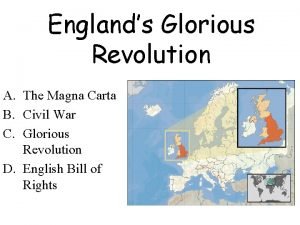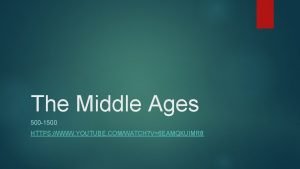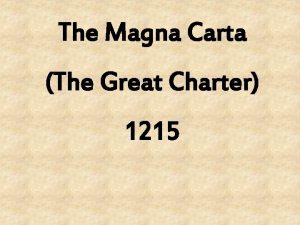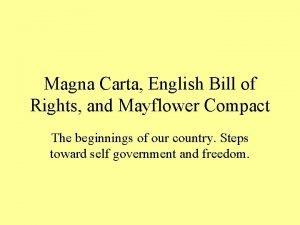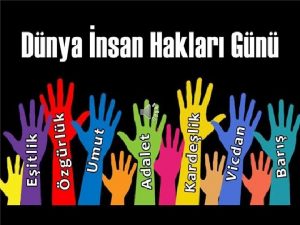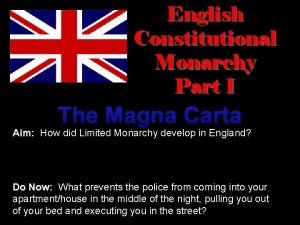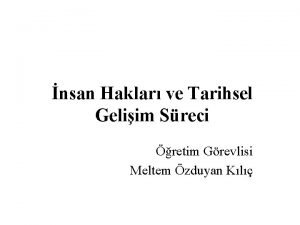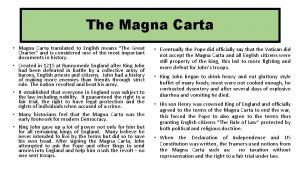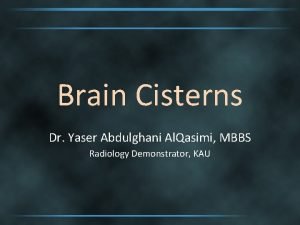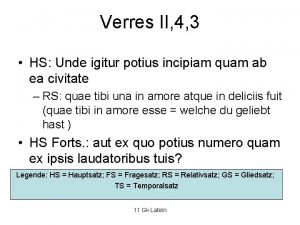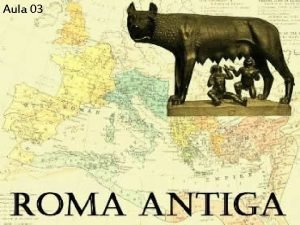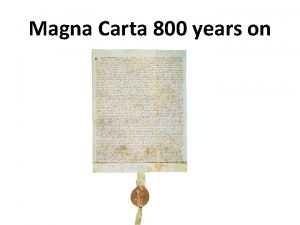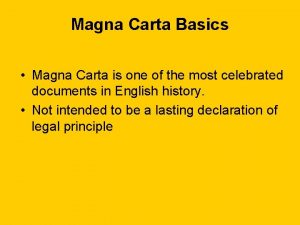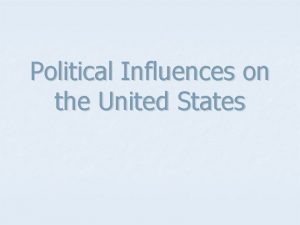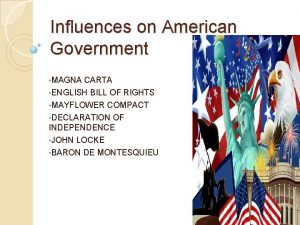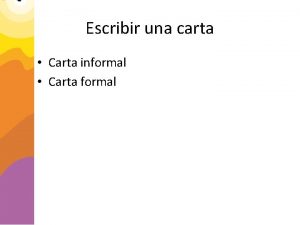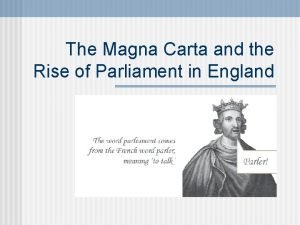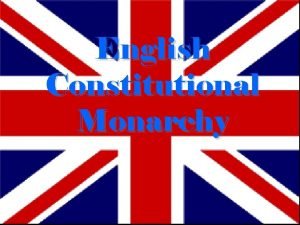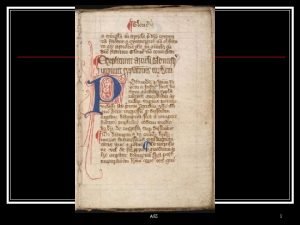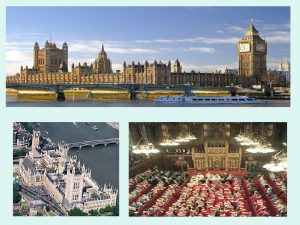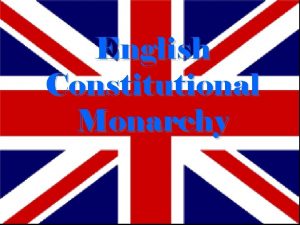Magna Carta What Is It Influences on US

















- Slides: 17

Magna Carta What Is It? Influences on US Constitution • (The Great Charter) • 1215 • Agreement between English Nobles and King John that guaranteed certain rights to the nobles; those rights later extended to all citizens. • No taxation without representation • Trial by jury • Citizens entitled to protection of the law • Monarch must obey laws; does not have absolute authority

The English Bill of Rights • 1689 • Drafted by Parliament after William and Mary came to the throne in the Glorious Revolution • Changed government from an absolute monarchy to a constitutional monarch, which placed limits on the power of monarchs Influence on the U. S. Government • Executive cannot suspend the legislature’s law • Legislature sets taxes • Freedom of Speech • Citizens can address the government about a complaint without fear of punishment

The Declaration of Independence • 1776 • Statement of reasons (grievances) why the American colonies had a right to separate from England • Written primarily by Thomas Jefferson • Influenced by ideas of John Locke (Life, liberty and property)

Declaration of Independence Influences on US Constitution *Incorporated rights expressed in the Magna Carta • All free citizens are political equals • Unalienable (natural rights) - life, liberty, pursuit of happiness – CANNOT be taken away by the government • Government gets its powers from the consent of the people • Citizens have right to change or abolish any government that threatens their unalienable rights • Executive (president) does not have absolute authority over the legislature and the judiciary • Military should be under civil control

The Federalist Papers What Is It? Influence on US Constitution • 1787 -1788 • A series of 85 newspaper essays in defense of the Constitution • Written by Alexander Hamilton, James Madison and John Jay • Increased support for the separation and division of powers and the system of checks and balances • Promoted federalism – the balance of power between the federal and state governments

Articles of Confederation

WHO? This document was adopted by the Second Continental Congress, but didn’t take full effect until it was fully ratified by the 13 independent states which was established on the first of March, 1781.

WHEN? The Articles of Confederation was ratified on November 15, 1777 in York, Pennsylvania.

WHY? The Articles of Confederation was created primarily as a system of government for the new nation.

WHAT? This document gave the 13 individual state governments’ more power than the Federal Government. .

INFLUENCES • It was the first governing document for the United States of America. • It established a Union for the thirteen states.

Details of the Articles of Confederation • Establish a confederation among states. • Each state gets one vote regardless of population. • The powers are divided between the state and national government. – Powers of national government- declare war, make peace, sign treaties, borrow money, establish a postal service, set standards for coins, weights and measures.

Weaknesses of the Articles of Confederation • • • No executive branch. No judicial branch. Congress could not collect taxes. The one vote rule was unfair to large states. Nine of thirteen states had to agree to pass a law. • All states had to approve an article to be amended. • No national unity.

The U. S. Constitution • Established in 1787 with the help of James Madison (father of constitution) Alexander Hamilton, and John Jay. • The Great Compromise offered a two house congress, equal representation in the senate, and representation based on population in the house. • Reasons of establishment – Needed a strong central government that unified the states. – Articles of Confederation didn’t work.

Details of the Constitution • Three branch government; judicial, legislative, and executive. • Each branch checks and balances each other. • Federalism – powers divided between states and national governments. • Constitution can be changed through the amendment process. • No rights to the people.

Bill of Rights • Established 1791 • The anti-federalists led by Patrick Henry, George Mason, and Richard Henry Lee pushed for a national bill of rights. • The people of the United States wanted their rights and freedom protected. • Bill of Rights make up first ten amendments of U. S. Constitution.

Details of Bill of Rights • • • Freedom of religion Right to bear arms Right to accuse persons Right to a speedy trial of one’s peers Rights and powers of people The biggest weakness was that it did not include native Americans, women or slaves.
 Of friendship by francis bacon
Of friendship by francis bacon Glorious revolution magna carta
Glorious revolution magna carta Magna carta
Magna carta Magna carta
Magna carta Document
Document Carta magna
Carta magna Mayflower carta
Mayflower carta Magna carta for teachers
Magna carta for teachers Magna carta
Magna carta Magna carta list
Magna carta list Magna carta school
Magna carta school Magna carta
Magna carta Magna carta
Magna carta Importance of batas pambansa 232
Importance of batas pambansa 232 Magna carta english translation
Magna carta english translation Cistern brain
Cistern brain Erat apud heium sacrarium
Erat apud heium sacrarium Magna grcia
Magna grcia

